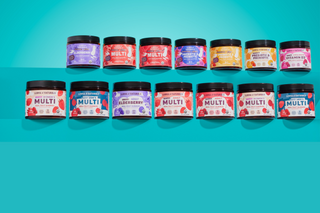Key Points:
- Vitamin D is an essential nutrient for your child’s bone health and immune health, among other things.
- There’s a lot of confusion between vitamin D vs. D3. In fact, the two forms of vitamin D are vitamin D2 and vitamin D3.
- These have slightly different chemical structures and come from different sources.
- If your little one isn’t getting enough vitamin D to support their health, consult your doctor to find out if they need a vitamin D supplement.

There’s a good reason why we all crave a little sunshine in our lives. It brings us a sense of well-being and relaxation — and it also has many other health benefits. That’s true for you as an adult and it’s especially true for your child. After all, they’re busy building the bone structure and immune system that will support them for the rest of their life. And those processes are powerfully influenced by their levels of vitamin D — or is that D3? Vitamin D vs. D3 … that’s the question.
Let’s explore what vitamin D is, the difference between vitamin D vs. D3, and the benefits of this critical nutrient for you and your child. We’ll also look at some sources of vitamin D to make sure you’re both getting enough to support your health.
What Is Vitamin D?
Vitamin D is a fat-soluble vitamin that your child needs for their body to develop and function well. It’s considered an essential micronutrient because the body needs it regularly. It differs from other essential nutrients in that the human body can make it, although only if it’s exposed to enough sunlight — which explains why it’s often called the “sunshine vitamin.”
Why Children Need Vitamin D

The effects of vitamin D are powerful, and growing children must get enough from an early age. Vitamin D supports the calcium absorption that’s so important to build and maintain healthy bones. Low levels of vitamin D — and therefore of calcium — put your little one at risk of rickets as a child and then of osteoporosis as they get older. It can also contribute to osteomalacia, a condition that causes bones to soften.
Vitamin D also helps with the absorption of magnesium, supports the nervous and immune systems as well as muscle movement, and helps cells to function properly. It may even help treat Covid.
But when it comes to vitamin D vs. D3, which should you be giving your child?
Vitamin D vs. D3: What’s the Difference?
The question here is not really the difference between vitamin D vs. D3, but between vitamin D2 vs. D3.
There are two forms of vitamin D: vitamin D2 (ergocalciferol) and vitamin D3 (cholecalciferol). Both of these nutrients are commonly referred to as “vitamin D,” understandably causing some confusion. Let’s get clear on the differences.
Chemical Structure
The chemical structures of these two forms of vitamin D are slightly different, but they’re both absorbed into the bloodstream. They then pass through the liver and kidneys, where they’re converted into forms of vitamin D that the body can use — known as serum 25-hydroxyvitamin D2 or serum 25-hydroxyvitamin D3.
Collectively, these two active forms are known as hydroxyvitamin D or calcifediol. If your doctor refers your child for a blood test, the lab is measuring their blood levels of calcifediol, as that indicates how much vitamin D is stored in their body.
Natural Sources of Vitamin D2 vs. D3

Another major difference between vitamin D2 vs. D3 is where they come from. Vitamin D3 is made by the human body and typically comes from animal sources (plus a few plant-based ones, like microalgae, lichen, and shiitake mushrooms), whereas vitamin D2 comes from plant sources.
Vitamin D3
When the cholesterol in your little one’s skin is exposed to sunlight, specifically ultraviolet (UV) light, their body makes that all-important vitamin D3. There’s a delicate balance here though.
The sunlight does need to be direct — through a window or on a cloudy day doesn’t produce much vitamin D3 — and on bare skin (sunscreen reduces absorption). However, because young skin is so sensitive, you need to make sure they don’t get too much sun exposure without sunscreen or you may increase the risk of skin cancer. If your little one is less than a year old, you probably want to keep them out of sunlight altogether. For children older than a year, 10-15 minutes is all they need, then you should apply that sunscreen liberally.
There are a few factors that increase the risk of vitamin D deficiency. For example, if you live in a cold climate or it’s winter, it’s difficult to get much vitamin D from the sun. And if your child has darker skin, they may not absorb as much sunlight, which affects their ability to get enough vitamin D.
Then you might need to turn to other sources, like food or dietary supplements, to boost your child’s vitamin D intake.
Some of the best food sources of vitamin D3 are often listed as fatty fish (which get their vitamin D from microalgae), fish liver oil, egg yolks, and organ meats like beef liver. Even if you can get your child to eat these though, there are some health and environmental issues, especially around fish. If you’re going to give your child oily fish, aim for fish at the lower end of the food chain, like sardines, rather than salmon or tuna.
Vitamin D2
Plants, on the other hand, make vitamin D2 when they’re exposed to sunlight.
The best plant-based sources of vitamin D2 are yeast and wild-grown mushrooms. It’s worth mentioning though that picking your own wild mushrooms can be risky. Some mushrooms are extremely poisonous, so you really need to know what you’re doing. Luckily, cultivated mushrooms that have been exposed to UV light are also an option.
The other problem here (unless you have a very unusual child) is that yeast and mushrooms aren’t exactly the most child-friendly food either.
Interestingly, when vitamin D2 is manufactured for supplements, it’s usually sourced from yeast exposed to UV light. Whereas vitamin D3 is often made from lanolin from the wool of (happily, live) sheep, or vegan D3 from lichen or algae.
Commercial Application in Food
You’ll have noticed many foods on supermarket shelves — including milk, breakfast cereals, and orange juice — that are marketed as being “fortified with vitamin D.” That’s vitamin D2 because it’s cheaper to make. If you decide to try those, make sure you read the label before you buy — they’re often packed with sugar and other undesirable ingredients like artificial colors and flavors, and/or preservatives.
Vitamin D Supplements

If you think your little one may not be getting enough vitamin D from sunlight or food (fortified or otherwise), you’re probably right.
According to the National Institutes of Health (NIH), the amount of vitamin D that children need depends on their age — and they don’t distinguish between vitamin D2 vs. D3. Babies of 0-12 months need 10 micrograms (mcg) or 400 international units (IU) of vitamin D each day. Older children and adults up to the age of 70 need 15 mcg or 600 IU, whereas adults over 70 need 20 mcg.
If you suspect your child may have a vitamin D deficiency, it’s important to seek medical advice from your healthcare provider. They may prescribe a dietary supplement for your little one — in which case, there’s a good chance that it’s a vitamin D2 supplement since they’re the ones available in high doses.
However, some studies indicate vitamin D3 may raise calcifediol levels more than vitamin D2.
Low-dose vitamin D3 supplements are available over the counter and in a wide range of forms, from chewable gummies or tablets to sprays and liquid drops.
Vitamin D3 is also often included in multivitamin supplements, like Llama Naturals Multivitamin Gummies for Kids.
Important Notes:
- Because vitamin D is fat-soluble, you’ll increase its absorption if you give vitamin D dietary supplements to your child with food that contains fat.
- While taking vitamin D is highly unlikely to cause side effects like vitamin D toxicity unless taken in megadoses, it can interact with some medications, like statins, steroids, and diuretics. So always check with your doctor first before giving your child supplements.
Hopefully, that’s cleared up any confusion between vitamin D vs. D3 (or vitamin D2 vs. D3).
Which Vitamin D Supplement Is Best?
Whenever you’re looking for vitamin supplements for you or your child, it’s important to go for the highest-quality supplements you can afford.
For example, Llama Naturals Raspberry Vitamin D3 Gummies are all-natural and manufactured with your child’s health front of mind. You’ll be happy to know that there’s no sheep’s wool involved. Instead, they’re made from real fruit, cooked slowly to extract all those juicy nutrients, plus vitamin D3 from plant-based lichen — and they’re delicious.
They’re also free from added sugar and artificial sweeteners, as well as artificial colors and flavors, preservatives, and common allergens like gluten. So you know that your little one is getting only the best.
That said, our Vitamin D3 gummies are in fact suitable for both adults and children. You just get to have two delicious gummies instead of one.
And in case you’re wondering, Llama Naturals Simply Strawberry Multivitamin Gummies for kids contain both vitamin D2 and vitamin D3 (both from plant-based sources) — so you don’t have to worry about which form to give them.
Vitamin D v. D3: What We Know for Sure

Your child’s vitamin D status matters. They need enough of this essential nutrient to develop a strong and healthy body and a resilient immune system.
The question of whether to go for vitamin D vs. D3 can be confusing, especially as vitamin D is often used interchangeably to refer to vitamin D2 and vitamin D3. These two forms have different chemical structures and come from different sources, but they both work to support your child’s health. Ultimately, we recommend vitamin D3, given its higher bioavailability.
If your little one is getting enough sunlight or is oddly partial to the small range of vitamin D-rich foods, they’re golden. Otherwise, you may need to invest in a vitamin D supplement or a multivitamin supplement from a top-quality brand. Your child’s health — and your own — depends on this essential nutrient.
Llama Naturals is a plant-based nutrition brand that has created the World's First Whole Fruit Gummy Vitamins that are made with no added sugar and whole-food vitamins. They are USDA Organic, Vegan, Gluten Free, free of common allergens, and are slow-cooked on low heat to retain rich phytonutrients & fruit flavor. It’s a win-win gummy vitamin that the whole family will love.






